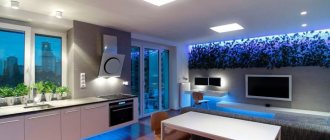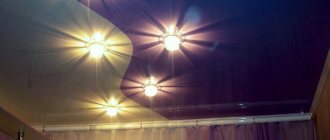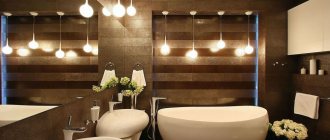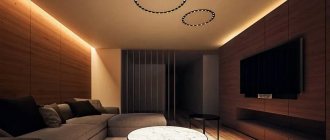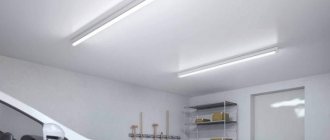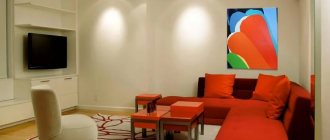Who is a lighting designer and why is one needed?
It is very difficult to think through a lighting strategy on your own without special skills. At first glance, the task seems feasible, but in practice it is rarely possible to correctly implement ideas. Common mistakes:
- Incorrect placement of lamps.
- Failure to comply with lighting standards.
- Inefficient distribution of sockets and switches.
- Lack of a plan for linking lamps to switching groups.
It is also important to understand the types of lighting and the characteristics of electrical appliances. In order not to delve into these issues, it is easier to trust a professional.
The main task of a lighting designer is to properly organize lighting. A specialist must be familiar with colors, interior styles, lighting equipment, and fashion trends. When developing the project, he is also guided by the climatic nuances of the region.
The first stage of a specialist’s work is creating a concept. The lighting designer evaluates the characteristics of natural lighting, plans the location of lamps, and considers the type and number of devices.
A professional knows how to complete the job in accordance with norms and standards. It will help organize designer lighting that will bring comfort to all occupants of the rooms.
An example of successful room lighting design
How interior lighting affects the space of rooms
Good lighting will highlight interior details, visually enlarge the space and make the room cozy. Some more interesting facts:
- Ceiling lights placed in a row will visually add height to the room.
- Reflective elements on the walls will visually expand the space.
- Lamps located longitudinally on the wall will visually “stretch” the room.
If there is not enough light in the room, it will look gloomy. Even the original design of the home will not correct the situation - all furnishings will appear in an unfavorable light. A poorly lit room will visually appear smaller than it actually is.
We present a photo that shows successful and unsuccessful lighting options. The image perfectly illustrates the influence of light on the perception of space.
An example of successful and unsuccessful room lighting
Designer tips
- Lampshades for correcting general light are placed under the ceiling in the center of the room (for uniform dispersion). Instead of a chandelier, it’s easy to distribute the lighting on 4 walls and multi-level ceilings.
- Work areas should be evenly illuminated; it is not advisable to leave dark corners and deep shadow areas, even if they are rarely visited. It is better to combine working light - white with a yellow spectrum (check when purchasing in a store).
- For decorative lighting, colored lighting is suitable, for example, LED strip or cords, which can be used to lay out inscriptions or figures on the walls.
- Indoor plants need special phytolamps for full development, especially if they are inhabitants of the tropics and southern latitudes.
- Aquarium hydrophytes are illuminated with “white” or universal fluorescent lamps on a special cover, in combination with diodes and incandescent lamps with soft yellow light. They heat the surface of the decorative lid, so they are placed at a distance, and the bottom is lined with foil.
- With the help of perforated sconce lamps and ceiling lampshades, you can get a beautiful openwork shadow pattern. But choose a smooth and monochromatic finish so that the texture does not distort the intricate image.
- Local or local glow should favorably emphasize certain objects and interior details, to a certain extent enhancing or replacing the decor.
- In the work area where they read, cook, or study at the computer, local lighting is needed. The intensity should be beneficial to the eyes; this is the case when you should not skimp on your health.
A simple floor lamp, but it suits the surrounding interior
Important! When arranging any point, remember about a certain amount of heat generated - the cladding should not overheat to the point of ignition. Consider physiological norms - lack of lighting inhibits work activity and relaxes the optic nerve.
Built-in LED lamps are ideal for suspended ceilings
See alsoTips for kitchen design with a ventilation duct at the entrance
Scenarios and rules of modern lighting
The main rule of lighting design is the choice of lamps for specific tasks. You should not place devices in the room that are unlikely to be used. To avoid mistakes, you need to think through the scenario.
You can combine several scenarios in one space. The most common option is a multi-level lighting system. This solution is especially relevant for spacious rooms. The scheme includes:
- Main ceiling lighting.
- Additional lights in certain areas of the room.
- Accent lighting for interior items.
- Creative lighting.
You can experiment with designer lighting as much as you like, but the organization of the main thing should come first. One chandelier or lamp is not enough, so it is important to think about how many light sources there will be in the room and how to arrange them. To do this, experts draw up a lighting scheme.
Multi-level lighting in the kitchen interior
Multi-level designer lighting in the living room interior
Lighting design for individual rooms: simple and complex
Light is not only functional, but also beautiful. Famous designers and architects will definitely take this important component into account when taking on a new project. A competent project will make your stay in the house comfortable and will help visually correct the space.
Each lamp in the room should have its own purpose.
Some elements can be shaded, others can be highlighted and draw maximum attention to them; a certain vector is set with directional light to “move away” or “bring closer” an object in the interior. Soft neon light creates an unusual effect when turned on from the head of the bed, the back of upholstered furniture, a plasma panel or along the perimeter of the “floating” ceiling. In this case, you don’t have to use a chandelier or other “classic” source of general light.
The light in the hallway is usually completely artificial; in the apartment the front door is removed from all windows. You can limit yourself to one luminous point near the ceiling if it is a tiny room. In the hallway combined with the corridor, make 3-4 dim lamps or sconces along the entire passage. For decorative purposes, you can use LED strip to decorate the baseboard and ceiling cornice. It is advisable to provide lighting to the mirror and the interior of the wardrobe. In a long corridor, a luminous path on the floor would be appropriate, and in a spacious room, a suspended ceiling with a beautiful lighting design would be appropriate.
To shorten a long hallway, you can place built-in lights along the ceiling and direct the light down
The bedroom is a special room where an intimate atmosphere is appropriate, which is created, to the greatest extent, by the play of light and shadow. The design depends on the size of the bedroom, interior style and furniture configuration. The classic version uses an elegant ceiling chandelier and 2 sconces (on both sides of the bed), while the modern version uses a variety of suspended ceilings and LED lighting (at the mirror and head of the bed). They often combine a ceiling with a “starry sky” effect and perforated sconces with openwork reflections on the wall. Some people like semi-darkness in their bedroom. But you don’t have to limit yourself to these ideas; the decision depends on the style and overall design concept, as in the photo.
Dim lighting is appropriate in the bedroom
In a modern living room, the main lighting design of the apartment is given to suspended or multi-level ceilings. If the classic version plays up the color of the ceiling and the shape of the chandelier, then new solutions in the age of high technology are unlimited. Buy a relatively simple lamp that can be switched from a remote control, or choose combination lighting with lower lighting for furniture.
In the living room, several types of lamps are used in accordance with the style direction of the room
The bathroom and toilet are a special room where you can experiment with lighting, which is unacceptable in a residential area. Try lights that gradually turn on and off, turn on with a clap, and more. It is important to take into account that this is a place with high humidity; wiring, lamps and lampshades should be as sealed as possible. LEDs near the mirror and bathroom are appropriate. For expensive hot tubs, this is the default option.
In the bathroom you need fairly bright light, but not harsh. Matte lamps built into the ceiling and a couple of devices for mirror illumination are suitable.
Light in the kitchen involves several zones with economical local lighting. This is a working plane and a place for eating, in addition to general light. Some people like large lampshades that flow down from the ceiling to the dining table. In a modern kitchen, you can make a frame near the ceiling with directed ray vectors. A gas stove with a backlit oven looks original - you and your guests can watch the process of frying chicken rotating on the grill. Additionally, diodes are appropriate at the bar counter and above the sink.
In the kitchen, directional lighting of work areas is combined with diffused light above the common space
Soft light in a children's bedroom is the basis of the design for this room. Rays that are too bright are harsh for the baby’s vision and irritate the psyche. And a deficiency can provoke myopia if children like to write, read and draw in the evenings. In places where they do homework or study at the computer, be sure to organize local lighting. An original night light with a children's theme will eliminate the fear of the dark at night, but it will not interfere with sleep if placed on the opposite side of the baby's eyes.
The children's room needs a high level of lighting, but without bright rays
In a studio apartment, everything depends on the local zones, but it is better if this is reflected in the design of the ceiling structure. Any accent can be the highlight of the concept, but do not forget that each functional area must have controlled power and intensity of the rays. For a large area, switches from different points to the general light or remote control are appropriate.
Additional lighting of individual zones is added to the main general light
Finally, one more important point - no matter how ideally artificial lighting is organized, do not forget about natural light, which plays a significant role in the design of a living space
The proposed examples in the photo will help you adopt ideas used by professionals.
See alsoKitchen design 2022: fashionable interior design solutions
Apartment lighting scheme
The first stage of creating a lighting system is preparing a lighting design project for each room. It's time to decide on the types and number of lamps and lamp power. The plan must indicate the lighting points in accordance with which the light sources should be located.
It is very important to choose switches and determine their location. Typically, each group of lamps is connected to a specific mechanism. Therefore, you need to place all devices so that they are convenient to use.
An excellent option is pass-through switches. With their help, you can control lighting fixtures from different points in the apartment. To implement such a solution, you need to think through the wiring diagram in advance.
Some more useful tips:
- Sockets and switches should be located in easily accessible places. According to the standard, at least one socket must be provided per 6 square meters of space. You can place more devices if the lighting system contains floor lamps, sconces and lamps that require individual connection to the network.
- It is better to place sockets at a height of 0.5-0.8 m from the floor. Switches - at a height of 0.6-1.5 m.
- To determine the optimal number of lighting fixtures per room, you need to multiply the area of the room by the recommended light level.
Advice! To be able to regulate the illumination from lamps, you can install special dimmer switches.
Light in the nursery
Linear lighting does not bypass the children's room. This is not just a room, but a whole world in which a child plays games, sleeps and makes his fantasies come true. That is why lighting fixtures must match his tastes and age.
You should not install a system that is too complex, which will be difficult for your child to cope with. Choose standard simple switches at the baby's height level.
You should definitely install a floor lamp or sconce near the bed, as kids may be afraid of the dark, and the ability to quickly and easily turn on the light will calm them down.
Lighting fixtures in the interior
Interior lighting is represented by different types of lamps. Instrument options:
- Chandeliers.
- Hanging lamps.
- Spotlights.
- Sconce.
- Desk lamp.
- Floor lamps.
Let's talk about each group of lamps. You will learn about the features of the products and be able to evaluate examples of interesting models.
Chandeliers
A chandelier is often used as the centerpiece of a lighting system. It becomes a bright accent and a source of powerful light flux. However, it should not become the only device in the room.
The design of the chandelier must be chosen depending on the height of the ceiling and the size of the room. If the room is small, a massive model will visually “steal” the space.
The design of the chandelier must correspond to the trends of the chosen interior style. Models with crystal horns and pendants will look great in classic and luxurious art deco. Modern trends allow you to experiment with the shape, color and size of devices.
The elegant Vitaluce pendant chandelier will fit perfectly into the living room. For the bedroom you can choose the fashionable Vele Luce Modena model. And Favorite Bulla will look great in a modern kitchen design.
buybuy
Vitaluce chandelier for the living room
buybuy
Vele Luce Modena chandelier for the bedroom
buybuy
Favorite Bulla chandelier for the kitchen
Advice! If there are several chandeliers in the room, it is better to choose models that are identical or similar in design.
Pendant lamps
Pendant lamps are often present in the lighting scheme of an apartment. They provide directional streams of light, so they are used to highlight individual areas of the room. Most often they are placed above kitchen and gaming tables, and a bar counter.
Suspended models are ideal for lighting design in rooms with high ceilings. Devices are rarely placed individually - more often in groups of 3-4 copies.
Examples of original lighting sources: the exquisite Globo Ticon model and the stunningly interesting Lussole Loft Bristol lamp in the shape of a badminton shuttlecock.
buybuy
Pendant lamp Globo Ticon
buybuy
Pendant lamp Lussole Loft Bristol
Sconce
Sconces are wall lamps that serve for local lighting. There are several types of products: open, near-surface, models on a bracket.
Near-surface specimens fit tightly to the wall. They are usually miniature lamps enclosed in a transparent housing. Such sconces emit soft reflected light, so they serve more as decorative lighting. Suitable for the interior of a bedroom, nursery, living room.
Open lamps are lamps without a shade. Outwardly, they are very similar to candles. Most often they decorate offices, living rooms and hallways. The sconces shine quite brightly, so they are suitable as a source of local lighting.
Wall sconces are lamps mounted on an adjustable arm. If desired, they can be brought almost close to the wall or, conversely, moved further away. Such devices are an excellent option for an office, library, or hallway.
Surface sconces in the interior
Sconce on a bracket in the interior
Open sconces in the interior
Desk lamp
Table lamps are a popular attribute in lighting design projects. From the name of the lamps it is clear that these are devices intended for placement on horizontal surfaces: countertops, shelves, cabinets. The products do not require special installation and look great in any room.
Table lamp in the interior
Floor lamps
Floor lamps are floor lamps on a high base. The devices are equipped with figured lampshades or laconic shades. A huge variety of designs allows you to choose a model to suit any interior style.
Original floor lamp in the interior
About light sources
Natural sources include sun rays, starlight, aurora, and moonlight. Artificial resources include fire: fires, torches, candles, gas lanterns, and electric lamps. The latter are divided into several types:
- incandescent lamps - contain a filament body, which produces the glow. A spiral of tungsten or carbon filament is placed in the design. A vacuum is then created in the flask. This helps prevent metal oxidation. At the moment the electrical circuit is closed, heating occurs, as a result of which the filament element begins to glow. The advantages of such lamps are that they withstand temperature changes well. They will work in a cold corridor or a hot bath without any problems. The disadvantage of such lamps is that they consume a lot of energy and produce a large amount of heat;
- halogen - their difference from the previous ones is that the flask is filled with halogen vapor. They are used for the most powerful devices. Gas allows you to significantly increase the temperature of the coil and extend the service life. Like conventional incandescent lamps, halogen sources use a large amount of energy to heat up. Another disadvantage is dependence on power surges;
- luminescent - flasks with a special coating applied on the inside. It emits light due to the constant combustion of vapors contained in the flask. Compared to conventional lamps, the service life of these devices is much longer. The obvious advantage is cost-effectiveness. Lamps consume 5-7 times less electricity than halogen lamps. The disadvantages include the difficulty of use - the need to use additional devices - a trigger mechanism, a starter. There are other disadvantages - flickering and sensitivity to low temperatures, air flows and environmental humidity;
- energy-saving - a subtype of fluorescent lamps. To the listed qualities of sources of this type are added the spiral shape and the presence of a standard base. Thanks to this, the lamps can be used in ordinary chandeliers and lamps without any additional structures;
- LED - revolutionary devices based on the use of LEDs. Unlike their predecessors, they do not heat up or flicker, and also withstand environmental influences and power surges well. The high cost of the devices is more than compensated by their long service life and unsurpassed low resource consumption.
Spot lighting in the interior
Spotlights (spots) deserve special attention. They emit directional streams of light that spread at a certain angle. As a result, you can illuminate the entire space of the room.
Types of spotlights:
- Built-in.
- Invoices.
- Track.
Recessed luminaires are devices whose housing is hidden in the ceiling or other surface where they are installed. The products are compact in size and versatile. They are almost invisible in the interior and perfectly complement more original lighting sources.
Surface-mounted lamps are mounted to the plane of the wall, furniture or ceiling so that the body is located in plain sight. Most often, such models have a laconic design, so they are not noticeable. They go well with other lighting fixtures and fit into any interior.
Track lamps are a relatively new trend in lighting design. This is the name given to devices mounted on the busbar trunking. The main advantage of the models is the presence of a rotating mechanism, which makes it possible to change the direction of the light flow.
Important! If spotlights appear as the main sources of lighting, they must be evenly positioned on the ceiling. The optimal distance between devices is no more than 1.5 m.
Track lamps in the interior
Spotlights in the interior
Lighting design rules
To avoid mistakes when organizing space lighting, several rules should be taken into account.
The mood and well-being of the person in it depends on the lighting of the room.
See alsoSwedish style in the interior: 10 rules of Swedish furnishings
Planning basic, task and decorative lighting
General light is devices on the ceiling that provide uniform diffused light. Most often these are chandeliers with several bulbs, textile or glass lampshades and shades. In no case should a lamp on the ceiling cast shadows or glare - this will ruin the entire atmosphere and will irritate the eye.
If a large chandelier is chosen as the main lighting, the light will be different in certain places of the room, but still without sudden changes
In the work area, it is better to install lamps that provide directional light - floor lamps, sconces or table lamps. This lighting must be brighter than the main one. In the kitchen, the work area is the dining table and food preparation area. Also, a place for reading books, the head of the bed, a place for doing homework or entertaining a child also needs special lighting.
The illumination level of the workplace should provide an optimal balance in which the eyes will not be strained
Only when the main and task lighting is comfortably arranged can you think about decorative lighting.
See alsoCombination of gray with other colors in the interior
Thoughtful lighting scenario
This is the most important stage in designing the design and lighting of the interior of an apartment. Moreover, this must be done individually for each room.
- In the hall, in addition to the main light, a working light is added in the area of a coffee table or a place for reading books. At the same time, decorative accents are required to give the space coziness.
- Often, general lighting is not required in the kitchen. It is enough to highlight each area with lighting: the dining area, for cooking. It is recommended to make functional LED lighting for the drawers.
- Lighting in the bedroom is organized according to the same principle as in the living room. Task lighting should be installed at the head of the bed. But the light in this room should not be bright, otherwise it will not contribute to proper rest.
- A bathroom does not always require several types of light. This is due to the small area. But if possible, it is worth highlighting the mirror area and adding decorative lighting. It could even be a nozzle for highlighting flowing water.
Light should complement the interior, and not “dampen” it
When working on a lighting scenario for an apartment, designers are advised to indicate what events will be held in the space in question. This will allow you to quickly select the right type of lighting and accurately determine the required number of sockets, switches, and dimmers.
Light walls and highly reflective furniture reduce the need for lighting fixtures
Don't forget about furniture. For example, a bedroom with matte surfaces will require more light than with gloss. This is due to the higher reflectivity.
See alsoMediterranean style in interior design
Calculations
No designer will begin to bring a project to life without the appropriate calculations. And this question is not about finance at all. It is necessary to consider whether all devices will operate in the same room. Will there be any unpleasant situations?
Drawing up a lighting plan allows you to avoid common mistakes that can ruin your interior design idea.
To implement this stage, it is recommended to contact specialists, since not even all designers do this themselves.
See also: Dark floors in interior design
Selection of characteristics
The types of lamps were discussed above, taking into account their distinctive features. The choice depends primarily on the lamp itself, the expected frequency of its use and functionality in the apartment. The light bulb in the device solves almost everything. In some situations, only classic incandescent lamps are suitable, while in others LED lamps are required.
Incandescent lamps are the cheapest, LED lamps are the most expensive
The higher the temperature of a light bulb in Kelvin, the cooler the light it emits. For a bedroom, up to 3000 (incandescent lamps) is enough, and for a work area – up to 5000. Lamps above 5500K are already used in offices. It is not recommended to use cold light in the dining area or near mirrors.
See alsoCreating an original interior of a house in the village
Lighting Design Trends
Interior fashion tends to change quickly. This directly applies to lighting design. We tell you what trends professionals use in decorating rooms.
Eco trends
Lighting devices made from natural and environmentally friendly materials are gaining popularity. Lamps with lampshades made of wood, thick paper, or stone look impressive. Lamps with wicker shades deserve attention. Such models are appropriate in almost all modern interior styles.
Chandelier made of elk antlers in the interior
Corrugated cardboard chandelier in the interior
Laconism and minimalism
First of all, this category of trends includes compact lamps in transparent shades. The devices look original and create a special atmosphere in the room. They are suitable as additional sources of general lighting and accent lighting of certain areas of the room.
Lamps in laconic round shades are at the height of fashion. They are considered universal because they combine well with other lighting devices.
Chandelier in the style of minimalism in the interior
Unusual shapes
Lamps with non-standard configurations are becoming fashionable. Triangular, square and trapezoidal lampshades will be a wonderful accent in modern designs. Lamps with balloon-shaped lampshades are very popular. They are ideal for installation in a nursery.
Original chandeliers in the interior
Types of ceiling lighting 2022
Classic ceiling lighting is a chandelier in the middle of the room, which can complement the style of the entire interior or, conversely, act as an accent item to which all attention will be focused. Modern chandeliers can have an unusual shape, original design or several levels of lighting. It all depends on the taste preferences of the owners of the room. However, with the development of technology and general attention to stretch or suspended ceilings, in addition to hanging chandeliers, built-in spotlights or lighting are actively used in design.
Spotlights perfectly highlight certain details and create the illusion of “light from the ceiling” or the “starry sky” effect.
As for the lighting, such lighting is an LED strip, which is located around the perimeter of the room or illuminates only some parts of it.
